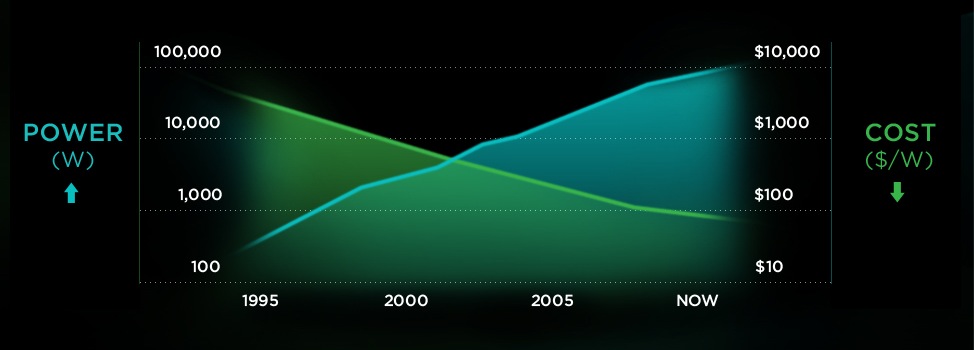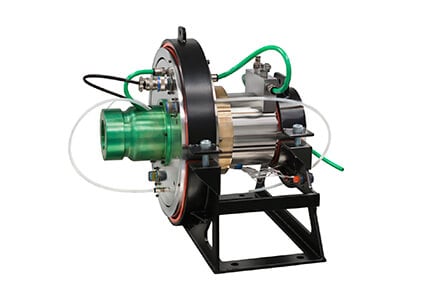OUR INNOVATIONS
Discussion and research on using high power lasers in the oil, gas, geothermal, and mining markets extends back to the 1960s. Until now the available high power gas lasers required high voltages and precision alignments that made them extremely large, inefficient, and too fragile to transport.
The fiber laser however consists of modular architecture of coupling individual high power laser diodes to an active fiber that is built from the “bottom up” to create higher and higher powers. This architecture gave rise to a logarithmic scaling of cost and power.
The experts consensus was that multi-kW, multi-mile high power laser transmission is “impossible”

Over the past decade, advancements in fiber laser technology have increased power availability from less than 1 kW to greater than 50 kW; reduced costs from greater than $1000/W to less than $50/W; and allowed rugged field transportation and operation.
Upon reaching technology critical mass, high-power lasers potentially will have the same type of impact on the oil, gas, geothermal, and mining industries that is occurring in the automotive, manufacturing, defense, and medical industries.
THE EVOLUTION
- 1917
Einstein first proposes the “Stimulated Emission” phenomenon that makes lasers possible
- 1951
Charles Townes conceives the M.A.S.E.R. (Microwave Amplification by Stimulated Emission of Radiation)
- 1957
Townes, Schawlow, and Gould lay the groundwork for the “optical maser” that later becomes known as the “laser”
- 1960
Theodore Maiman builds the first laser at the Hughes Research facility
- 19161
N. Holonyak Jr. invents the semiconductor laser which later becomes a core building block of the fiber laser
- 1962
E. Snitzer invents the Nd:Glass laser which later becomes part of the core architecture of the fiber laser
- 1964
The movie Goldfinger brings lasers into the pop culture and visualizes industrial laser cutting for the first time
- 1964
C.K. Patel invents the high power CO2 laser but at large sizes and alignments that limit rugged transport
- 1970
Fiber optic cable made of corning glass allows long distance, low loss transmission of laser power
- 1974
The bar code scanner is introduced and first used to ring up a pack of Wrigley gum
- 1977
Live telephone traffic is sent through fiber optic cables in downtown Chicago
- 1978
Laser Disk hits market as the first commercial optical disc storage medium
- 1980
M. Ross and R. Rice invent diode pumped laser which later becomes part of the core architecture of the fiber laser
- 1980
Chu, Cohen-Tannoudji, and Phillips work with laser cooling of atoms that wins them the 1997 Nobel Prize
- 1982
Compact Discs, the next iteration of laserdisc technology, extends playing time, sampling rate and linear resolution
- 1994
Lasers used for remote sensing resolution in oilfields
- 1995
M. Zediker and R. Rice demonstrate first high power fiber laser
- 1996
DVD introduced, providing much more storage in the same size as the compact disc
- 1997
Ramona Graves finds that lasers can achieve a number of basic rock destruction mechanisms
- 2003
Gapontsev and IPG enters market with high power fiber lasers
Fiber laser costs have dropped from over $1,000/W to less than $50/W in just 15 years.
STIMULATED BRILLOUIN SCATTERING (SBS)
Stimulated Brillouin Scattering (SBS) is a “physics effect” that chokes off the transmission of high power laser photons in a fiber optic cable by reflecting the energy backwards to catastrophically destroy both the fiber optic cable and laser source. In short, photons and acoustic phonons interact in a vicious cycle that gets exponentially worse with increasing power and distance.
Foro Energy started with the three governing equations of SBS to build a foundational physical understanding of the phenomenon and the resulting impact on high power laser transmission.
With advanced physics simulations and experimental capabilities, Foro Energy developed a solution where the fiber optic cable, laser source and combined system are simultaneously engineered to eliminate the onset of Stimulated Brillouin Scattering. This gives us the unique capability to transmit high power lasers in fiber optic cables over long distances.
Stimulated Brillouin Scattering (SBS) is a “physics effect” that chokes off the transmission of high power laser photons in a fiber optic cable by reflecting the energy backwards to catastrophically destroy both the fiber optic cable and laser source. In short, photons and acoustic phonons interact in a vicious cycle that gets exponentially worse with increasing power and distance.
Foro Energy started with the three governing equations of SBS to build a foundational physical understanding of the phenomenon and the resulting impact on high power laser transmission.
With advanced physics simulations and experimental capabilities, Foro Energy developed a solution where the fiber optic cable, laser source and combined system are simultaneously engineered to eliminate the onset of Stimulated Brillouin Scattering. This gives us the unique capability to transmit high power lasers in fiber optic cables over long distances.
LASER HARDWARE PLATFORM
Foro Energy’s proprietary technology overcomes limitations to allow “world’s first” transmission of high power:
- High power, by overcoming SBS
- Over long distances, by overcoming SBS
- With low loss, through a proprietary fiber optic specification
- In downhole environments, through a proprietary cabling package
INTELLECTUAL PROPERTY
Foro Energy is a global leader in the applications of high power lasers for the oil, natural gas, geothermal, and mining industries with over 50 issued patents globally





